Breaking down silos to achieve a more enabled workforce and more informed stakeholders.
Tim Taylor is an industry solution executive at Ventyx, an ABB company.
Electric distribution operations are changing rapidly as the application of operations technology (OT)—particularly two-way communications, intelligent devices, and SCADA—is changing the way distribution systems are monitored and controlled. In the same way, evolving information technology (IT) continues to affect distribution operations, with seemingly endless advances in mobile technologies, analytics, systems integration, and computing platforms.

Historically, OT and IT for distribution operations were developed, maintained, and used by different silos in the organization. However, the concept of IT-OT convergence isn’t new, as Gartner defined the concept in the mid-2000s. Practical examples exist at many distribution organizations, but only a fraction of the potential benefits in the industry have been realized. While technical and organizational challenges exist for those looking to cross IT-OT boundaries, there are compelling business reasons and strong technology drivers for increased IT-OT convergence in distribution operations.
Experience has shown that benefits of IT-OT convergence can include improvements in an electric system’s performance, an organization’s business processes and decision-making effectiveness, and its customer satisfaction. Going beyond the smart grid enabled by field automation devices only, where much investment has been made in the last several years, IT-OT convergence is fundamentally changing distribution operations, enabling: a smarter grid, with system optimization; a more effective workforce, with better-enabled employees; and more informed stakeholders, through closer connections with external parties.
IT-OT convergence will continue to be a leading contributor to improving distribution system performance and organization productivity over the next decade. However, now more than ever, distribution organizations need to plan their IT and OT strategies not one application at a time, but as a comprehensive portfolio of applications that must work together to support the organization’s goals.
Improving Organizational Effectiveness
There are no industry-standard definitions of IT and OT for electric distribution operations. IT is traditionally associated with back-office information systems that are used for conducting business-type transactions, such as cost and tax accounting, billing and revenue collection, asset tracking and depreciation, human resource records and time-keeping, and customer records. Manual data entry is often involved, and the computing resources are likely to be in office locations, server rooms, and corporate data centers.
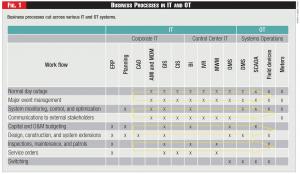
OT is typically associated with field-based devices connected to the distribution system, and the infrastructure for monitoring and controlling those devices. This includes control center-based systems such as SCADA and distribution management systems (DMS). Most communications is performed device-to-device, or device-to-computer, with relatively little human interaction.
Plainly, historic barriers between IT and OT still exist, but now they’re being overridden by the organizational objectives and operational goals that today’s distribution organizations are expected to achieve. To meet those objectives, the electric distribution industry must overcome numerous challenges—including controlling system operations and maintenance (O&M) costs—particularly in light of aging infrastructure and high percentages of the workforce that are nearing retirement—while maintaining or improving system reliability. Maintaining or improving customer service, and finding the most effective way to communicate with customers using web-based and social media, is another challenge. Increasing system efficiency, reducing peak demand, and helping customers conserve energy is a priority for many organizations.
One component of an effective strategy for meeting the challenges above is business process reengineering. However, when performing this reengineering, distribution organizations recognize without exception that their different business processes cut across both OT and IT systems (See Figure 1).
To enable the new business processes to be as efficient as possible, the IT and OT systems must work together. If not, results can include poor decision making resulting from a variety of shortcomings—involving unavailable information; poor data-management processes (e.g., excessive manual data entry, data entry duplication, or cumbersome reporting and compliance methods); poor system performance; or slow and ineffective communications and reporting to external stakeholders.
Enabling Technologies
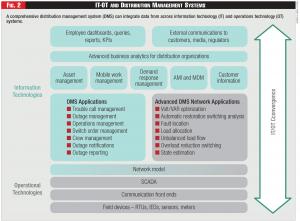
Clearly, distribution organizations must integrate the different IT and OT systems in order to improve the performance of their organizations. Fortunately, recent technology developments are enabling this integration.
For example, remote data collection and communications capabilities have improved prospects for IT-OT integration. The cost to collect and transmit operational data continues to trend downward. Simple, economic CPUs mean distributed intelligence will continue to expand, not only into every facet of our lives, but also throughout key locations on the distribution infrastructure. The quantity of data available for short-term operational situational awareness, as well as for analytics aimed at longer-term capital investment O&M planning, will continue to increase and provide value in the organization’s processes.
Better standards also serve integration goals. Some operational technologies, such as SCADA, DMS, and outage management systems (OMS), have been using standard IT platforms for some time, including Linux- and Windows-based software running on IP-enabled networks. This standardization enables IT organizations to economically procure and manage all its resources, including OT, since such systems can be configured and monitored with standard network management resources. And interoperability standards developed by numerous bodies, including IEC and IEEE, are being employed as they mature. These standards include IEC 61968, the Common Information Model (CIM) for distribution management. CIM will cover various aspects of distribution operations, AMI, distributed energy resources, and demand response. The maturation of such standards is key to facilitating further IT-OT convergence.
IT hardware also has become more cost-effective. Processor power, disk storage space, and network capacity all continue growing in accordance with Moore’s Law and its corollaries. The result is continued downward cost pressure on IT infrastructure throughout the OT and IT domains, providing the economic, high-scale computing capacity that will be needed for wide-scale distribution automation and advanced data analytics.
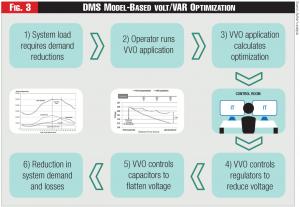
At the same time, software systems also are improving. In the last 10 years, the technologies available for system integration have evolved substantially. Real-time messaging middleware has made it possible to apply some of the principles of enterprise application integration (EAI) to distribution operations. Presently, the trend for linking many IT and OT applications is the development of web services in a service-oriented architecture, although a hybrid system architecture in which other interfaces, such as point-to-point, will be economically competitive for particular applications.
Mobile computing and data access also facilitate integration. Extending, inspecting, operating, and maintaining a distributed asset infrastructure means that many distribution work processes are field-based. The escalation in mobile computing, data access, and even digital photography and video will result in substantial changes to a range of distribution activities. Examples include inspections, design, situational awareness, equipment operating history, switching, damage assessment, field resource optimization, and inventory tracking. In the future, field crews will have much more access to operational data, some of which will be in near-real-time.
Full Distribution Management
As these technological drivers enable the convergence of IT and OT, this convergence in turn enables distribution organizations to integrate all the components necessary to move toward a truly full distribution management system (see Figure 2). The operational technologies include intelligent electronic devices (IED), remote terminal units (RTU), meters, and other field equipment that communicate back to the control center. While revenue meters typically use AMI communications infrastructure, the other devices use the SCADA communications infrastructure. A single network model of the system, which explicitly represents the system connectivity and electrical characteristics, is shared across both the OMS and the advanced DMS applications. The converged SCADA, OMS, and DMS are integrated with the other IT systems. Advanced business analytics, developed specifically for electric distribution organizations, connect to all the systems and provide meaningful information, tailored for different individuals internal and external to the organization.
By making this full distribution management system possible, IT-OT convergence offers numerous benefits to the distribution organization, as well as to its customers and partners. When properly implemented, IT-OT convergence can assist distribution organizations in three areas: 1) system optimization, with a smarter grid; 2) better-enabled employees, via a more effective workforce; and 3) closer connections with external parties, with more informed stakeholders.
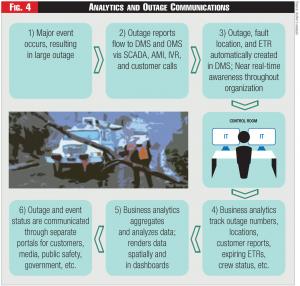
Likely the most significant change occurring in distribution operations is the use of model-based distribution management systems. A model-based DMS uses an as-operated network model, which typically is linked to the organization’s geographic information system (GIS). The operating states of the selected components in the DMS model, such as switches, breakers, fuses, etc., can be manually changed by system operators or changed via an interface to the SCADA system. The SCADA system can transmit equipment status changes and analog values from field equipment, and can be used to initiate device control changes to field equipment.
A real example of system optimization is the model-based volt-VAR optimization (VVO) application, which is in production at Oklahoma Gas & Electric (OG&E). The VVO application continuously monitors the distribution network and computes the optimal distribution control settings to minimize an objective function of MW demand, MW energy loss, or both, subject to voltage and current violations in three-phase, unbalanced and meshed distribution systems. VVO computes the optimal control settings for switchable capacitors and tap changers of voltage regulating transformers. The optimized system condition is based on the current load flow solution performed on the system model. The volt-VAR optimization then transmits the required control actions to the OT devices, such as capacitor switch status or voltage regulator tap position (see Figure 4). For the distribution organization, the benefits can include a reduction in the amount of generation capacity that must be built or bought on the market, and a reduction in the real energy losses on the system.
Other examples of how IT-OT convergence improves distribution operations include model-based fault location, isolation and service restoration (or FLISR)—which can reduce customer interruption durations—and the use of data from a meter data management (MDM) system for system optimization.
Another increasing IT trend is the application of business analytics software that can extract data from OMS, WMS, SCADA, and other OT systems to provide dashboard information and querying capabilities for the entire workforce. The dashboards, which now are available as cost-effective pre-packaged—or out-of-the-box—solutions, can be tailored to the specific job function in the organizations; that is, different dashboards can be created for operations, for customer service representatives, for senior management, etc. Users can drill down and drill across data to get more details, if needed. As a result, improved situational awareness provides the workforce with the right information at the right time, in order to make the right decision.
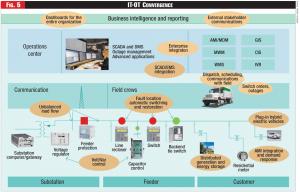
Data from various OT systems can also be sent to the back-office IT systems, such as a business analytics system or enterprise asset management system, to make better decisions related to longer-term asset management processes. Increasingly, OT data is being analyzed with data mining, pattern recognition, and statistical analysis. ABB and Ventyx are introducing new asset health models in a business analytics offering for this purpose. Data from sensors and on-line monitoring equipment—including temperature, pressure, historic equipment loading, duration and frequency of short-circuits and through-faults, as well as number of operations and other OT quantities—all can be used in the IT environment by asset managers to make better decisions about maintenance programs and asset replacement. Potential benefits include the conversion of unplanned outages into planned outages—if it’s economically practical to do so—as well as reduction in the number of catastrophic outages, and better allocation of capital and maintenance budgets.
IT-OT convergence is enabling distribution organizations to keep their external stakeholders better informed about their electric service. Such information can be related to service outages, power pricing as a function of time or usage, special offers and programs, and other information about electric power service that a distribution organization wishes or needs to share.
IT-OT convergence is particularly important during major events like storm restoration, when information about outages, network loading and status, field resources, and damage assessment all must be coordinated within the organization in a short timeframe. This needs to be done to provide information to customers, government officials and regulators, such as the amount and location of system damage, and estimated times to restore (ETR). Technology exists to do this now. Many utilities already are extracting data from OMS, MWM, GIS, CIS, AVL, and other systems, verifying the data, and presenting selected near-real-time situational information to external stakeholders. This capability will only continue to grow, as data availability within the distribution organization increases, and business intelligence and analytics continue to mature.
Organizational Considerations
The benefits of IT-OT convergence for distribution organizations can be substantial. However, there are still practical considerations to address to realize those benefits. Considerations are generally centered around data, training and technology. They include:
• Data modeling: What are the best standards to apply, such IEC 61968, to enable data sharing among different applications? How can data structures be shared across departments? How should an organization adapt as distribution data standards mature?
• Data ownership and access: What should the data governance model be for the organization? Who should be the owners of the different types of data? What systems should be considered the master system for different types of data? What levels of access should be granted to users with different responsibilities? What’s the best way to manage user authorities?
• Data quality: How good does the data need to be for different applications? For example, if IT data that was traditionally used in an offline mode is now applied in an operations environment, what extent of data scrubbing is needed to ensure correct operations? What data validation needs to be in place? What standard operating procedures or workarounds need to be in place to deal with data that is missing or erroneous?
• Training: What training is required for operations resources to become more familiar with IT practices? If the IT department becomes more responsible for OT systems like SCADA, what’s the best way to build their competence on OT systems?
• Scalability: What’s the best way to ensure scalability of communications, sensors, databases, and applications, to handle both present and future needs?
• Security: What are the legitimate security concerns regarding the numerous intelligent devices, and possible hacker entry points, in OT systems that now will be integrated with IT systems? How will local and federal compliance standards and guidelines continue to evolve, and what will distribution organizations need to do to address those?
Smart Convergence
The convergence of IT and OT in the electric distribution industry is changing the way organizations perform their work, and it’s increasing organizational performance. This convergence will affect many different work processes and will result in a smarter grid, a more effective workforce, and more informed stakeholders (see Figure 5). Benefits include improved system efficiency and reliability, lower operating and capital costs, and enhanced customer satisfaction. Implementation considerations include data modeling, quality, access, and ownership, as well as training, scalability, and security.
Since IT and OT systems continue to evolve, and the level of OT data continues to increase as more intelligent devices and communications are added to the grid, IT-OT convergence will continue to grow as a key enabler of present and future performance improvements.



